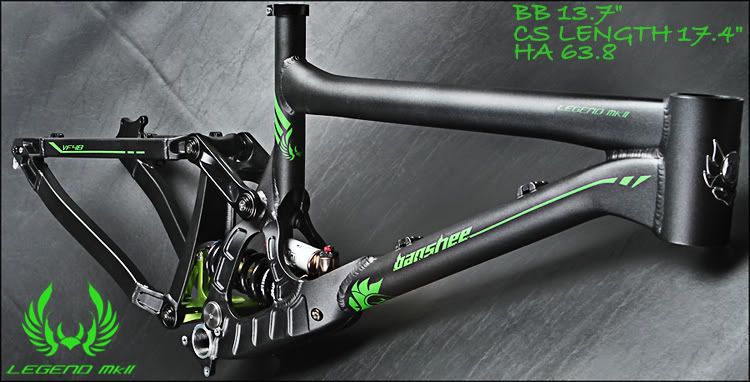Wheel Size Facts Part 2.... Rollover Factors
 Saturday, November 2, 2013 at 8:05AM
Saturday, November 2, 2013 at 8:05AM Part 2 from the boys at Banshee Bikes.....
Here is some more independant wheel info to help you decide which wheel size is for you. I will be taking the same dimensions as discussed in Part 1 to perform these calculations. These theoretical calculations do NOT take into account tire deformation... which I will talk a bit about later. This week, get ready to deal with everyone's school subject fav - some trigonometry! So belt up, and let's rollover some wheel-based maths (oh dear....!)
'Rollover':
You'll almost definitely have heard 29er riders saying just how much better their bikes roll over obstacles on the trail. "I carried so much more speed through that rough section!", or something similar. This is probably the key reason that riders and manfacturers give for having a bigger wheel size... But what does this mean, and just how much better do they perform this action?
The diagram below (Fig. 1) shows the height of a square-edge obstacle, and the angle of attack vis-à-vis the wheel:

Fig. 1 When a wheel makes contact with a square-edge obstacle (for example, the curb of a pavement - that's British speak for 'sidewalk'), the angle of attack = the angle of the tangent of the wheel at point of contact with the square edge obsticle and the horizontal as shown above.
 Fig. 2 how each wheel size's angle of attack varies with obstacle height across a range of square-edge obstacle heights. Of course these values are all perfect and theoretical (not taking into account tire deformation, tire pressure or bike lean angles etc.)
Fig. 2 how each wheel size's angle of attack varies with obstacle height across a range of square-edge obstacle heights. Of course these values are all perfect and theoretical (not taking into account tire deformation, tire pressure or bike lean angles etc.)
The angle of attack itself doesn't really tell you much without applying basic trigonometrical functions to to break it down into horizontal and vertical force vectors. In a simplified form without friction or deformation, if a wheel runs into a vertical obstacle higher than the axle height, it will stop you instantly (horizontal force / vertical force = infinity). Conversely, if an obstacle has zero height it will not slow you down at all (horizontal force / vertical force = 0). On Fig. 3, you can see how the force vector varies as obstacle height increases for each wheel size (the higher the Tan (Angle of Attack), the more it will slow you down):

Fig. 4 shows how the force vectors vary as a % relative to the 650b wheel. A positive number represents a higher horizontal resistance (effectively, this means it slows you down more). So, you can see that 26" wheels will slow down more than 650b wheels which in turn will slow down more than 29".
This graph clearly shows that the relative efficiency is not consistent across all obstacle heights. The larger the obstacle, the larger the effect the wheel size will have. So it is impossible to say that one wheel is x% more efficient over square-edged hits than any other size without saying the size of obstacle, tire size, and tire pressure etc etc.

It should also be said that not only are big wheels more efficient at rolling over square-edge hits, but they also result in a smoother ride. This is because, for any given speed, the larger the diameter of the wheel the longer it is in contact with the obstacle (i.e. it hits it sooner and leaves it later). Therefore it has longer to react to the obstacle. Plus, the bigger the wheel the less of it is going to drop into holes (think braking bumps), hence 29ers feel like they smooth the trail out.
Once again I want to make it very clear that these numbers are based on wheels that do not deform at all, and that are rolling over perfectly square-edged obstacles, which is obviously not realistic. So let's have a quick look at some real world factors that significantly complicate the situation.
Tire deformation helps to absorb the impact of hitting a square-edge obsticle. This not only reduces the shock that is transferred to the frame and rider, but also makes the wheel roll more efficiently over an obstacle by effectively reducing the angle of attack when it absorbs it. The more the tire absorbs the obstacle the better, so actually lower pressure tires roll over obstacles like this more efficiently (unless you get a snake bite!).
Tire size is an important factor... for example you could realistically have a larger outside diameter running a very high volume tire on 26" wheels than a small volume tire on a 650b wheel. In this situation the 26" wheel would roll over things better than 650b, so tire height should be considered if analysing options.
We have indeed confirmed that big wheels roll over obstacles better than small wheels, and help maintain momentum as a result. But frame geometry and axle path also play a factor if the frame has suspension, as the suspension can help absorption of obstacles and make the bike roll over them better. The slacker the head angle or more rearward the axle path, the better a bike will roll over an obstacle if all other factors are equal.
Plus there is one very very significant factor that none of these numbers take into account...We can bunny hop over things! This is why you should never listen to arguments taken from automotive industry as the car can't be thrown around independently of the driver.
If this second installment of wheel physics hasn't boggled you even more than the first part, the third blog post will tackle contact area and grip. Woop!
 29er,
29er,  650b,
650b,  Wheel Size |
Wheel Size |










